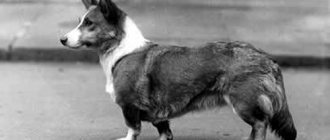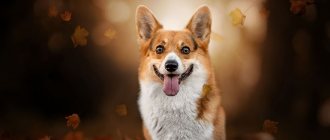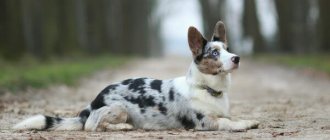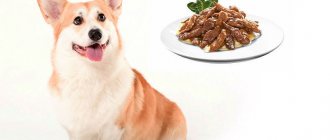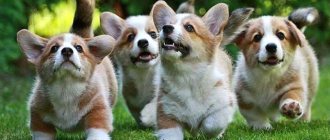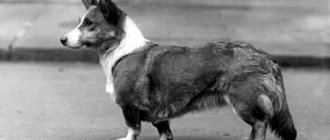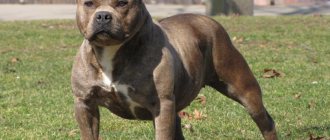The Welsh Corgi was talked about back in the 10th century, but despite the fact that the breed was attractive from the point of view of breeders, they remained in the shadows for a long time.
Wales is recognized as the homeland of the corgi, where the animals have decorously and faithfully played the role of a shepherd dog for centuries.
This left a certain imprint on the breed itself.
In appearance, this is a short dog, but very active and friendly, which is ready to win over anyone.
Description of the breed and photo of what it looks like
The Welsh Corgi is a type of herding dog from the Shepherd family, but in a shortened form.
These are small, stunted dogs that barely reach 30 cm in height and 14 kg in weight..
The Corgi is characterized by an elongated body and a pair of erect ears, the size and type of which vary depending on the species.
The coat is shiny, silky, and there are established rules for its color.
For example, there are no exclusively white corgis..
Legend of appearance
The homeland of dogs, as the name suggests, is Wales. In this part of the United Kingdom there are a large number of castles, according to legend, Camelot was located here, and the Knights of the Round Table met here. It is not surprising that in a region rich in legends, the history of the Corgi breed has been endowed with mythical origins.
According to folklore, these dogs were given to people by fairies. According to one version, two farmer's children found puppies in the forest and mistook them for fox cubs. Returning home and showing the find to adults, it became clear that these were small dogs. According to another version, the fairies gave the lost children a corgi puppy, which led them to the farm.
Due to its similarity with foxes, the most popular nickname for the Pembroke Welsh Corgi is Fox (from the English fox - “fox”). According to legend, fairies used small dogs for riding and also harnessed them to harnesses. To support this, admirers of the myth provide evidence - a “mark” from the fairies’ saddle on the back of the neck in the form of a darker area of fur. The legend is beautiful, but it cannot be written down in the official description of the breed standard. Therefore, let's get acquainted with more real facts.
Advantages and disadvantages
Among the advantages are sociability and friendliness; the breed is not demanding and not intrusive.
Due to its compact size, it gets along well in apartments and can become a good companion for both the owner and the family . But she suffers from a love of humanity, and therefore is extremely unreliable in the role of a security guard or watchman.
If corgis run after people, it is only to gather them into a group. These are herding dogs whose genes encourage everyone to herd. People tend to get grabbed by the heels. So as not to fight back.
However, this does not in the least prevent the dog from having a loud voice, which in an apartment complex is more of a minus than a plus.
Also, corgis do not easily succumb to fear, which means they can get into trouble if they come into conflict with a larger associate . In terms of health, animals also have many disadvantages.
Dogs are prone to a number of diseases: be it problems in the musculoskeletal system, spinal cord damage, skin diseases (eczema) or problems during childbirth, when outside intervention is impossible.
Vellabrand's disease (poor blood clotting) cannot be ruled out either.
Origin of the Corgi
In the name of the breed, two whole words describe the place where the dog appeared - the county of Wales and the Pembrokeshire estate. In the neighboring Cardiganshire estate, another line of Welsh Corgis developed - the Cardigan. And the word “corgi” has several interpretations:
- From the Welsh "kor" - dwarf and "gi" - dog.
- From the Old English "cur" - "to guard, to take care."
In the first version, the definition of “dwarf” refers to the size of not only the dog, but also the mythological owners of the first corgis - fairies and gnomes.
When exactly the name “Corgi” was assigned to Welsh dwarf dogs, the history of the breed is unknown. At the end of the 19th century, they were presented at exhibitions under the name Heeler (from the English heel - “heel”). They were so called because of their habit of biting animals in the herd on the heels. The varieties of the breed also had their own names:
- “a yard-long dog” is for a cardigan;
- “stocky dog” – for Pembroke.
The history of the Welsh Corgi breed is difficult to trace. It is known to be the oldest in Great Britain. The first written mentions of the short shepherd dog are found in records of the 10th century. There she is described as a dog for herding cows. This is exactly what the Corgi breed was bred for.
Thanks to their small height, which did not exceed 30 cm, Welsh Corgis easily avoided being hit by cows and bulls.
They nibbled the animals' legs, giving them direction. It is known that dogs were highly valued in their homeland. For killing a corgi, the defendant had to provide the owner with an ox.
Neighboring Scandinavian dogs took part in the appearance of herding dogs. They came to the territory of Wales together with their Viking masters. There, Scandinavian dogs crossed with local dogs. It is believed that the ancestors of the Welsh Corgi are two breeds:
- Swedish Vallhund;
- Icelandic dog.
From the first corgi he inherited an elongated body and short legs, from the second he inherited a fox face. Both breeds are herding breeds.
Types of Welsh Corgs
There are two types of corgis: Pembroke and Cardigan.
The Cardigan Welsh Corgi is named after the territory of Cardiganshire, where this variety originated. Compared to Pembrokes, the Cardigan's paws are longer, and therefore the breed is widely used in work.
However, to date, corgis are much more often involved in the role of a show dog than a herding dog.
The corgi's head shape is similar to that of a fox . The ears are large and slightly rounded. The dog's chest is wide, and its back is straight and strong. Compared to the Pembroke, the size of the Cardigan is larger and the tail is longer.
NOTE!
If the tails of Cardigans are free from the encroachments of breeders, then the tails of Pembrokes are docked even in puppyhood, although sometimes they are already born bob-tailed.
Pembroke is recognized as the homeland of the Pembrokes . The dogs have a bright, golden coat, with white markings on the chest, paws and face. The mouth is accompanied by a line that often creates the feeling that the dog is “smiling.”
The head, like that of the cardigan, resembles that of a fox, with a smooth transition from the forehead to the muzzle. The ears are medium size, rounded. The tail is often docked.
Pembroke Welsh Corgi breed standard
At exhibitions held in accordance with the standards of the RKF and IFF, representatives of the Pembroke Welsh Corgi are evaluated according to certain criteria. They are listed in a document published on November 4, 2010. Thus, the breed is included in the group of guard and racing dogs, which are classified as shepherd dogs. At each exhibition, in the case of corgis, experts focus on the exterior of the animals. Therefore, every dog must be harmoniously built and have an intelligent look.
Attention!
The character of the exhibition individual also plays a significant role. The dog must not be aggressive or cowardly; such corgis will be disqualified.
Head and muzzle
According to the standards, the Corgi should have a fox-shaped head. At the same time, the expression of the muzzle is not cunning, but more friendly and interested. Representatives of this breed do not have an angry appearance. The skull is flat, there is a sufficiently large distance between the ears, the correct length to width ratio is 5:3. The nose is black, the eyes are oval, the edges of the eyelids are mostly dark. When an imaginary line is connected between the tips of the ears and the nose, an equilateral triangle should emerge.
Frame
The dog is stocky, but agile and energetic. Although there is a tendency to be overweight, therefore, the main feature of care is the ban on uncontrolled eating.
Attention!
You cannot give your corgi food outside of the schedule and at the pet’s first request.
The distance from the withers to the tail is approximately 40% greater than the height of the dog. The loin should not be too long and the neck should not be too short. The chest of Corgis that meet the standards is slightly narrowed towards the lumbar area. It’s bad when the dog’s bones are very light or, on the contrary, rough and heavy. Apart from the above, the dog should not be extremely short.
Tail
Dogs have the bobtail gene and it is dominant. Even when one of the parents is a bobtail, there will be puppies with short tails in the litter. This is due to the strength of their genes. Corgis with a tail are not disqualified, but they are not valued as much. The natural tail should be positioned to look like an extension of the back. He never lies on his back or curls up, but when the dog is happy or moving, he can be lifted up.
Limbs
The limbs are short, but flexible and strong. The lower part is oval, the pads are collected in a “lump”, and the 3rd and 2nd fingers protrude slightly. The metatarsus and metacarpus are wide, straight, powerful, and there is no narrowing. The elbows are close to the sides, there is a right angle between the forearm and the shoulder blade. The thighs are extremely muscular. Wide spacing of the paws is not typical for representatives of the breed; steps should not be weaving or mincing. At the same time, the movements are free, but not loose.
Coat and color
The guard hairs are elastic and elastic, the undercoat is dense and does not get wet, 1 tone darker than the prevailing color. The coat is moderately hard, its length may vary slightly, depending on gender, living conditions, and heredity. There are 2 basic colors - red-black-white and orange-white. Tri-colored puppies may appear bi-colored up to 1 month of age. The following basic color options are recognized as standards:
- Black-headed tricolor - the muzzle and ears are black, as is the “saddle” on the back with red outlines. The belly and limbs are white.
- Deep tricolor - the head is red, there may be a dark spot between the ears. The "saddle" is slightly smaller than in the case of the black-headed tricolor, but its edging is wider. The thighs are black with white spots.
- Red-white with a “collar” - the color ratio is approximately equal, but the collar area is always white.
- Red-headed tricolor - faded-red tan, small black saddle zone.
- Standard red-and-white is a classic color, the intensity of shades ranges from faded fawn to intense red-and-white. A black “mask” may be present.
- Sable and white is a variant of red and white, with sable coloring on the neck, body and head. It appears only in dogs over 3 months of age; it cannot be predicted earlier.
On a note!
The fluffy gene - soft, wet and flowing long hair - is considered as a congenital deviation with a sign of a similar breed. They are not allowed to compete, but they are not disqualified either - they are full-fledged. Although some dog handlers consider fluffy unacceptable.
Are there differences in the behavior and care of Pembrokes and Cardigans?
Trying to find differences in corgi care prompts you to take a closer look at the dog's coat. So, for example, Cardigans have shorter and thicker hair, while Pembrokes have hair that looks like a soft fur coat.
Therefore, it is not surprising that the latter shed more profusely, and accordingly, they need to be combed more often.
In behavior, Pembrokes demonstrate cheerfulness and a love of physical activity, which is why they are recommended for active owners..
However, increased excitability will not be a problem when trying to approach your pet. The Pembroke is easy to control, but it is recommended to train it in a game format.
The dog will quickly get bored with the monotony and will begin to avoid such pastimes..
Unlike their counterparts, cardigans are distinguished by prudence. These dogs better understand the owner’s mood and are able to adapt to it. They are cautious in business and do not like to act on emotions. Predisposed to training.
Who is better to choose - a boy or a girl?
Welsh Corgis have weakly defined sexual characteristics, although differences are still present. The male is physically stronger and more powerful than the female.
In terms of character, the question is somewhat simpler.
Despite the fact that both dogs are non-aggressive and get along equally well with both children and other pets, the female is easier to control and quickly finds a common language with other cohabitants.
Conflicts often flare up on the part of male dogs, and animals are also not averse to “hitting girls.” Especially if nature has endowed the male with love from birth.
The same bitch will tolerate the absence of a groom without any problems and will gladly prefer the company of her owner to the attention of other dogs.
Modern history of the breed
Throughout the 20th century, two varieties of Welsh Corgis, the Pembroke and the Cardigan, were actively crossed. This is currently avoided in order to preserve the purity of both breeds.
The history of the Welsh Corgi breed knows a case when puppies from the same litter took first places at shows of both Pembrokes and Cagrdinags.
These were a male Pepper and a female Jill. At one time, Pepper was so in demand as a sire that it was difficult to find a corgi that was not related to him.
Looking at the good-natured, playful dogs, it’s hard to remember why the Corgi breed was bred. They love active games and will happily accompany their owner on long walks. But they will stay at home with no less pleasure. Corgis are easy to care for, have low food requirements and are in good health. They have high intelligence and quickly master commands. Professional Welsh Corgi breeders claim that this dog is suitable for anyone.
Until 1892, the breed was not widespread. The situation changed after 1933, when the future Queen Elizabeth II and her sister were given Welsh Corgi puppies by their father. Young Elizabeth immediately fell in love with the cute dogs. She remains true to this affection to this day.
Pets and children
Corgis are herding dogs that have long been a friend and companion to humans, so life among people is natural for them.
Welsh Corgis are not predisposed to aggression, and they perceive the family as a “herd” that must be preserved and protected..
Not to mention the cubs, who are not at all able to defend themselves if necessary. Therefore, corgis are welcome in any family with children.
Are you picky about feeding?
Corgis are not selective when it comes to feeding; on the contrary, the breed has poor control over satiety and is prone to overeating, so the diet should be selected in advance.
Welcome:
- beef;
- turkey breast;
- beef stomach;
- cereals (rice, buckwheat);
- dairy products;
- vegetables and fruits.
In the case of industrial feeds, repeated changes of brands and flavors are detrimental to the health of the animal . Veterinarians advise sticking to one option and resorting to replacement only under pressure from circumstances.
Are they difficult to care for?
Corgis are easy to care for. The fur does not need to be cut; it is enough to brush it regularly (at least once a week). In winter, dogs also do not freeze; a good undercoat saves the corgi from this.
Therefore, clothes are also of little use. It is customary to check dogs' ears at least once a month and trim their nails at least once a month. Caution is advised when using shampoos.
As a rule, they deprive dogs of fat, which takes time to restore.
IMPORTANT!
Corgis also love active recreation, so dogs will be happy if the owner shares this passion.
Ideally, 2-3 walks are required daily so that the pet satisfies its need for physical activity, otherwise it risks finding solace in food and becoming like a bedside table.

